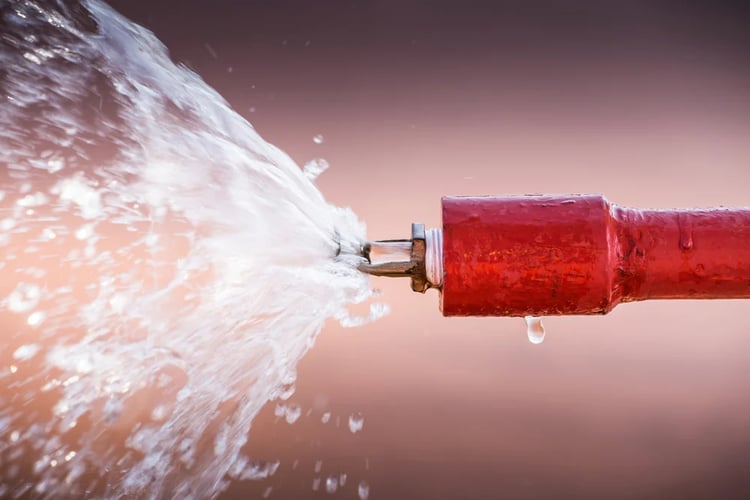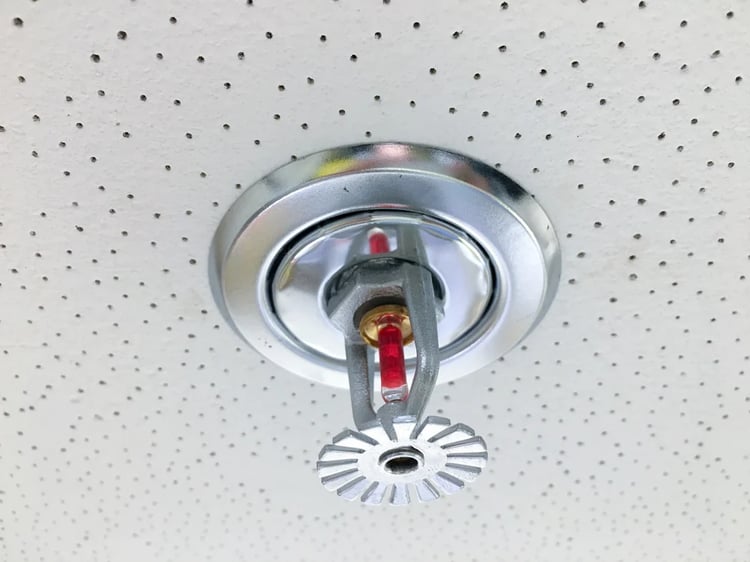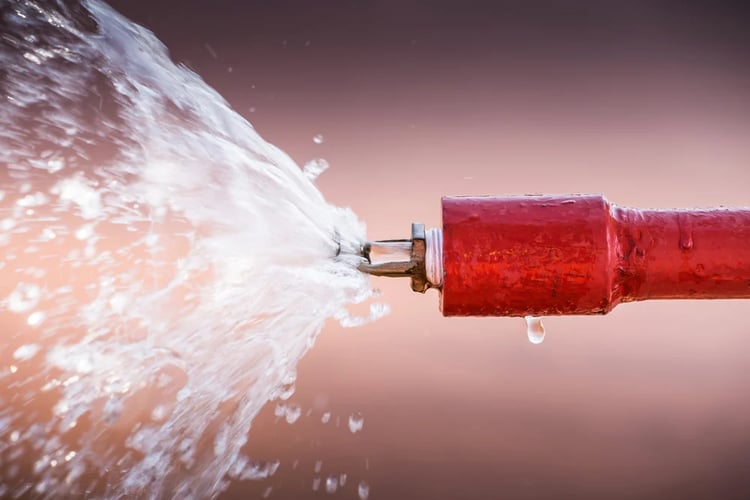Hydraulic calculations are very important in the design of fire protection systems, as they ensure that the piping provides enough water to extinguish any fire. In particular, automatic sprinkler systems are subject to NFPA 13 in the USA, and the equivalent international standard is EN 12845.
The hydraulic calculation procedure addresses three very important aspects of a fire suppression system:
- If a fire occurs, how much water will it take to put it out?
- Is the available water supply sufficient?
- What is the ideal piping system layout and what friction losses are produced?
Get your hydraulic calculation report for just $500
Proper fire protection design protects your building and its occupants. If you are developing commercial spaces for rent, reliable fire protection is also a valuable asset for potential tenants.
How much water is needed for fire protection?

A water flow test is required before starting a hydraulic calculation. This can be accomplished by measuring pressure and flow at a fire hydrant, but this information may also be publicly available from the municipal water department.
There may be cases where the municipal water supply is insufficient for fire protection or unavailable. When this happens, the piping can be designed to capture water from other sources, which can be classified as open or closed:
- Lakes, ponds and rivers are examples of open sources.
- Underground, above-ground, and elevated water tanks are examples of closed fountains.
When water is obtained from a static source such as a lake or buried tank, additional pressure is required for effective fire protection. This must be considered in the hydraulic calculation procedure, and the pressure increase can be achieved with a fire pump or pressurized tank.
Piping System Settings
The piping layouts of most fire protection systems can be classified into three main types based on how the individual pipes are arranged: tree, loop, and grid.
| Piping configuration | Description |
| Tree | This setup uses a main pipe that branches into smaller pipes, similar to a tree that has branches growing from its trunk. Branch pipes supply water to individual sprinklers and other fire protection elements. |
| Link | This configuration also has a main tube, from which all other tubes branch. However, the main pipe returns to the starting point, completing a loop at the source. |
| Grid | This configuration uses two main lines parallel to each other, connected by smaller pipe segments. There is more than one route leading to each sprinkler, which reduces friction. |
Fire protection standards typically require the Hazen-Williams method to determine friction losses in a piping system, regardless of the layout used:
- Tree and loop piping layouts have a simpler procedure and manual calculations are feasible.
- On the other hand, network pipe layouts require software to analyze and balance water flow through all possible paths.
Modern fire protection systems are typically designed with computerized calculations, regardless of the layout used. Software calculations allow changes and recalculations in just a fraction of the time required with manual procedures.
There are many factors that influence the intensity and extent of a fire, which include the materials stored in a building and their arrangement. Fire protection codes provide typical design tables and values from decades of testing and detailed simulation of fire incidents. The NFPA 13 Manual has a supplement that covers the theory and procedures behind hydraulic calculations.
Calculating sprinkler density based on demand

Occupancy hazard rating is a critical factor when designing an automatic sprinkler system. If the fire risk is underestimated, the resulting sprinkler system will be undersized for fires that may occur. The system will not be able to extinguish the flames, causing extensive material damage and possible casualties.
The hazard classification should be determined by experienced fire protection engineers. There is no calculation procedure and the analysis is qualitative – it depends on experience and familiarity with NFPA standards.
- Based on the hazard classification, fire protection engineers can determine the optimal layout of fire piping and sprinklers.
- The next step is to determine the maximum number of sprinklers that can be activated at once and calculate the pressure required to ensure sufficient water flow.
- In any scenario with sprinklers less active than the maximum assumed, the piping and water supply will be more than sufficient.
The number of sprinklers considered in design calculations is primarily determined by the hazard classification. However, there is freedom to make adjustments that are considered appropriate by the designer.
The NFPA provides charts that establish a relationship between covered area and flux density. Fire protection designers select an appropriate combination of area and density depending on the application.
- Fire sprinkler design can vary from high flow density over a small area to low density over a large area.
- In both cases, the objective is to control the fire before it spreads outside the projected area.
How to calculate sprinkler flow requirements?
The flow calculation is relatively simple, as design engineers only need to multiply the area covered and the flow density that was previously determined:
- Q (flow) = Coverage Area x Flow Density
The sprinklers listed typically have minimum flow requirements in their technical specifications, which depend on spacing. The manufacturer's flow requirements shall prevail if they exceed calculated values.
Looking for sprinkler system design services?
How to calculate sprinkler pressure requirements?

Calculating pressure is more complex, as sprinklers involve a conversion of pressure energy into kinetic energy. The calculation uses the formula for water flow through an orifice, based on the pressure inside the tube:
- Q (flow) = 29.83 x C D xD 2 x√P
- C D is the discharge coefficient, which is based on the characteristics of the orifice and determined experimentally.
- On the other hand, t The letters of P simply represent diameter and pressure.
Because fire sprinklers already have a design diameter, all factors except pressure can be combined into a “K-factor” for simpler calculations. This results in a more compact formula:
- Q = K x √P
When the required flow (Q) is known, the formula can be rearranged as follows to calculate the required pressure (P):
- P = (Q / K) 2
NFPA 13 establishes a minimum pressure of 7 psi, even when the calculation procedure produces a lower value. This ensures that the sprinklers produce the correct spray pattern. However, NFPA 13 also provides exceptions to the method, which are covered in Chapter 7. The following are some examples:
- Applications where dry pipe sprinkler systems are used.
- Fast response sprinklers under flat, smooth ceilings with limited height.
- Unsprayed and combustible hidden spaces in a building.
- Spaces divided into multiple compartments, where alternative methods allow for a smaller number of sprinklers.
- Housing units and adjacent corridors, which use a simplified procedure with a designed area of four sprinklers.
Conclusion
Automatic sprinkler systems have strict design requirements, which makes sense given their importance in fire protection. Designing a sprinkler system that meets regulations at an optimal cost is an engineering challenge that requires experience in fire protection and familiarity with regulations.
In New York City, all commercial properties covered by Local Law 26 were required to have fire sprinklers by July 1, 2019. If you have a property that has not met the deadline, the best recommendation is to contact a company qualified MEP engineering team as quickly as possible.

